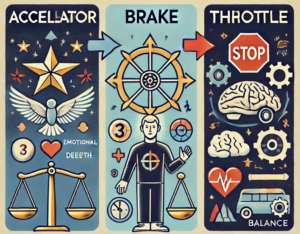 Integration of Cognitive Functions
Integration of Cognitive Functions
The accelerator/brake/throttle model of the Enneagram also offers an intriguing parallel to cognitive functions in psychology, particularly as described in Jungian and post-Jungian theories.
Accelerator types (8, 3, 7) show a strong correlation with extraverted cognitive functions. These functions are oriented towards external action, engagement with the environment, and objective data processing. For instance:
– Type 8’s assertive and action-oriented nature aligns with Extraverted Thinking (Te), which focuses on organizing the external world and taking decisive action.
– Type 3’s goal-oriented and adaptive qualities resonate with Extraverted Feeling (Fe), which is attuned to external feedback and social dynamics.
– Type 7’s exploratory and enthusiastic approach mirrors Extraverted Intuition (Ne), which seeks novel possibilities and connections in the external world.
Brake types (5, 9, 4) align more closely with introverted cognitive functions, which are focused on internal processing, subjective interpretation, and reflective analysis:
– Type 5’s deep analytical nature corresponds with Introverted Thinking (Ti), which seeks internal logical consistency and deep understanding.
– Type 9’s desire for inner peace and harmony resonates with Introverted Sensing (Si), which compares present experiences with past ones to maintain stability.
– Type 4’s focus on personal meaning and emotional depth aligns with Introverted Feeling (Fi), which processes emotions and values internally.
Throttle types (1, 2, 6) represent a fascinating balance between extraverted and introverted functions:
– Type 1’s perfectionism and ethical focus could be seen as a blend of Ti (internal logical framework) and Te (organizing the external world to match internal standards).
– Type 2’s interpersonal awareness combines Fe (attunement to others’ needs) with Fi (internal processing of relational values).
– Type 6’s strategic thinking and vigilance reflect a mix of Ne (anticipating possibilities) and Si (comparing with past experiences for security).
Neurobiology Connections
The accelerator/brake/throttle model of the Enneagram also aligns intriguingly with current understanding of neurobiology and brain function.
Accelerator Types (8, 3, 7) and Dopaminergic Systems:
These types might indeed show higher sensitivity or activity in dopaminergic pathways. Dopamine is associated with motivation, reward-seeking behavior, and action initiation – all characteristics of accelerator types:
– Type 8’s assertiveness and desire for control might be linked to high dopamine activity in the nucleus accumbens, associated with reward and motivation.
– Type 3’s achievement orientation could be related to increased dopamine signaling in the prefrontal cortex, involved in goal-directed behavior.
– Type 7’s novelty-seeking tendencies might correlate with heightened dopamine activity in the ventral tegmental area, associated with exploration and anticipation of rewards.
Brake Types (5, 9, 4) and Serotonergic Systems:
These types might show more pronounced activity in serotonergic systems. Serotonin is associated with mood regulation, impulse control, and a sense of well-being – aligning with the reflective nature of brake types:
– Type 5’s tendency for detached observation might be linked to balanced serotonin activity in the prefrontal cortex, allowing for regulated emotional responses.
– Type 9’s desire for inner and outer peace could be associated with serotonin’s effects on the amygdala, modulating anxiety and stress responses.
– Type 4’s emotional depth and introspection might relate to serotonin’s role in the hippocampus, involved in memory and emotional processing.
Throttle Types (1, 2, 6) and Balanced Neurotransmitter Systems:
These types might demonstrate a more dynamic balance between various neurotransmitter systems:
– Type 1’s quest for improvement might involve a balance between dopamine (driving action) and serotonin (enabling self-control).
– Type 2’s interpersonal focus could involve oxytocin (the “bonding” hormone) alongside balanced dopamine and serotonin activity.
– Type 6’s vigilance and strategic thinking might relate to a dynamic interplay between the noradrenergic system (involved in alertness) and GABA (the primary inhibitory neurotransmitter), allowing for both caution and action.
